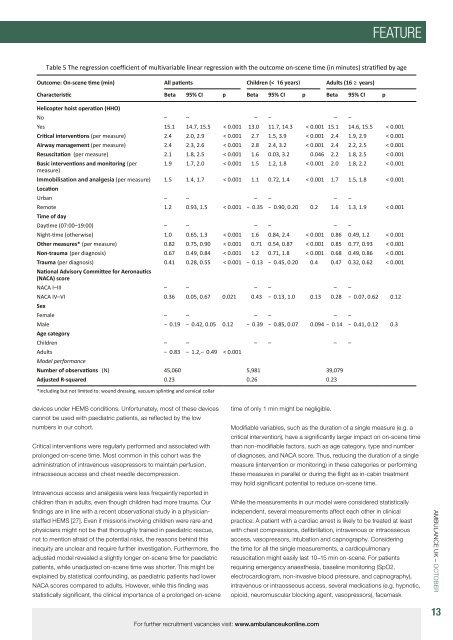Ambulance UK October 2023
Ambulance UK October 2023
Ambulance UK October 2023
You also want an ePaper? Increase the reach of your titles
YUMPU automatically turns print PDFs into web optimized ePapers that Google loves.
FEATURE<br />
Table 5 The regression coefficient of multivariable linear regression with the outcome on-scene time (in minutes) stratified by age<br />
Outcome: On-scene time (min) All patients Children (< Adults (16 ≥ years)<br />
Characteristic Beta 95% CI p Beta 95% CI p Beta 95% CI p<br />
Helicopter hoist operation (HHO)<br />
No – – – – – –<br />
Yes 15.1 14.7, 15.5 < 0.001 13.0 11.7, 14.3 < 0.001 15.1 14.6, 15.5 < 0.001<br />
Critical interventions (per measure) 2.4 2.0, 2.9 < 0.001 2.7 1.5, 3.9 < 0.001 2.4 1.9, 2.9 < 0.001<br />
Airway management (per measure) 2.4 2.3, 2.6 < 0.001 2.8 2.4, 3.2 < 0.001 2.4 2.2, 2.5 < 0.001<br />
Resuscitation (per measure) 2.1 1.8, 2.5 < 0.001 1.6 0.03, 3.2 0.046 2.2 1.8, 2.5 < 0.001<br />
Basic interventions and monitoring (per<br />
measure)<br />
Location<br />
*including but not limited to: wound dressing, vacuum splinting and cervical collar<br />
1.9 1.7, 2.0 < 0.001 1.5 1.2, 1.8 < 0.001 2.0 1.8, 2.2 < 0.001<br />
(per measure) 1.5 1.4, 1.7 < 0.001 1.1 0.72, 1.4 < 0.001 1.7 1.5, 1.8 < 0.001<br />
Urban – – – – – –<br />
Remote 1.2 0.93, 1.5 < 0.001 − 0.35 − 0.90, 0.20 0.2 1.6 1.3, 1.9 < 0.001<br />
Time of day<br />
Daytime (07:00–19:00) – – – – – –<br />
Night-time (otherwise) 1.0 0.65, 1.3 < 0.001 1.6 0.84, 2.4 < 0.001 0.86 0.49, 1.2 < 0.001<br />
Other measures* (per measure) 0.82 0.75, 0.90 < 0.001 0.71 0.54, 0.87 < 0.001 0.85 0.77, 0.93 < 0.001<br />
Non-trauma (per diagnosis) 0.67 0.49, 0.84 < 0.001 1.2 0.71, 1.8 < 0.001 0.68 0.49, 0.86 < 0.001<br />
Trauma (per diagnosis) 0.41 0.28, 0.55 < 0.001 − 0.13 − 0.45, 0.20 0.4 0.47 0.32, 0.62 < 0.001<br />
National Advisory Committee for Aeronautics<br />
(NACA) score<br />
NACA I–III – – – – – –<br />
NACA IV–VI 0.36 0.05, 0.67 0.021 0.43 − 0.13, 1.0 0.13 0.28 − 0.07, 0.62 0.12<br />
Sex<br />
Female – – – – – –<br />
Male − 0.19 − 0.42, 0.05 0.12 − 0.39 − 0.85, 0.07 0.094 − 0.14 − 0.41, 0.12 0.3<br />
Age category<br />
Children – – – – – –<br />
Adults − 0.83 − 1.2, − 0.49 < 0.001<br />
Model performance<br />
Number of observations (N) 45,060 5,981 39,079<br />
Adjusted R-squared 0.23 0.26 0.23<br />
devices under HEMS conditions. Unfortunately, most of these devices<br />
cannot be used with paediatric patients, as reflected by the low<br />
numbers in our cohort.<br />
Critical interventions were regularly performed and associated with<br />
prolonged on-scene time. Most common in this cohort was the<br />
administration of intravenous vasopressors to maintain perfusion,<br />
intraosseous access and chest needle decompression.<br />
Intravenous access and analgesia were less frequently reported in<br />
children than in adults, even though children had more trauma. Our<br />
findings are in line with a recent observational study in a physicianstaffed<br />
HEMS [27]. Even if missions involving children were rare and<br />
physicians might not be that thoroughly trained in paediatric rescue,<br />
not to mention afraid of the potential risks, the reasons behind this<br />
inequity are unclear and require further investigation. Furthermore, the<br />
adjusted model revealed a slightly longer on-scene time for paediatric<br />
patients, while unadjusted on-scene time was shorter. This might be<br />
explained by statistical confounding, as paediatric patients had lower<br />
NACA scores compared to adults. However, while this finding was<br />
statistically significant, the clinical importance of a prolonged on-scene<br />
time of only 1 min might be negligible.<br />
Modifiable variables, such as the duration of a single measure (e.g. a<br />
critical intervention), have a significantly larger impact on on-scene time<br />
than non-modifiable factors, such as age category, type and number<br />
of diagnoses, and NACA score. Thus, reducing the duration of a single<br />
measure (intervention or monitoring) in these categories or performing<br />
these measures in parallel or during the flight as in-cabin treatment<br />
may hold significant potential to reduce on-scene time.<br />
While the measurements in our model were considered statistically<br />
independent, several measurements affect each other in clinical<br />
practice: A patient with a cardiac arrest is likely to be treated at least<br />
with chest compressions, defibrillation, intravenous or intraosseous<br />
access, vasopressors, intubation and capnography. Considering<br />
the time for all the single measurements, a cardiopulmonary<br />
resuscitation might easily last 10–15 min on-scene. For patients<br />
requiring emergency anaesthesia, baseline monitoring (SpO2,<br />
electrocardiogram, non-invasive blood pressure, and capnography),<br />
intravenous or intraosseous access, several medications (e.g. hypnotic,<br />
opioid, neuromuscular blocking agent, vasopressors), facemask<br />
AMBULANCE <strong>UK</strong> – OCTOBER<br />
For further recruitment vacancies visit: www.ambulanceukonline.com<br />
13
















